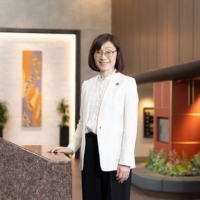Where did all the gyaru (trashy girls) go? With their carroty tans, shoveled-on makeup and bleached hair, the kogaru (high gals), ganguro (black faces) and yamamba (ogresses) were a style phenomenon the likes of which may never be seen again.
Though a few stragglers persist in sporting the look, the demise of Alba Rosa -- the fad's emblematic brand -- makes this an appropriate time to close this odd chapter of Japanese fashion history.
With its hibiscus motif and fluorescent colors, Alba Rosa was the must-have label at the height of the kogaru craze from 1998 to 2001, when you would see its logo at every turn in Shibuya. Established in 1975, the brand had been doing well among free-spirited gals and guys into something that said: I'd rather be in Hawaii.
Those gyaru boom years also saw the business turn to megabucks with over 60 stores nationwide carrying its merchandise. It still has nine of its own stores, seven franchises and some 40 stockists, but on August 28, the brand will be taken off the shelves and its stores will close forever.
It is a spectacularly rapid demise. In 2004, sales were 6 billion, yen yielding a 918 million yen operating profit. Figures for 2005 are not yet available, but anecdotal evidence suggests that Alba Rosa has drifted way off the Tokyo fashion radar; a trip down to Shibuya's gyaru drag Senta Gai turned up one lone sighting -- a bag faintly embroidered with the hibiscus logo, whose owner expressed only mild consternation at the brand's demise.
The reaction was somewhat more animated at Queue, a secondhand store which, until recently, dealt almost exclusively in Alba Rosa clothing and accessories. "I'm devastated," screeched owner Mari Noguchi, who says she has been collecting the brand since its inception 30 years ago and started Queue to recoup some of the huge sums she was shelling out on its products.
It all started going downhill last summer, she explains with a long face. "The senta-guys [male yamamba who take the look to comical extremes] started wearing it as a kind of uniform. The brand's supposed to be about a healthy, outdoors look and they were ruining the image. The president was furious and ordered everything to be made too small or too feminine for them to wear, but that drove away existing customers and by then it was too late anyway, the damage was done."
Noguchi says she'll miss her beloved Alba Rosa, but that she is diversifying into different brands and her customers are doing the same. She is, however, looking forward to the six-day "best-of" bonanza to be held Aug. 22-28, when the brand will offer limited editions of classic pieces from the past 30 years.
Can she offer any clues as to where all the gyaru went? "O-ne-kei [big sister style]," she says, adding that prissy, conservative outfits like Burberry Blue Label and Clathas are increasingly popular.
The gyaru look may have been in dubious taste, but it was provocative, rebellious and uniquely Japanese. With most mainstream fashion in Japan either demure secretary style or copies of trashier European catwalk gear from China and Korea, it almost seems like a return to orange tans and silver hair would be welcome . . . almost.



















With your current subscription plan you can comment on stories. However, before writing your first comment, please create a display name in the Profile section of your subscriber account page.